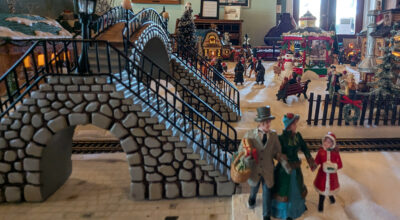Published 12:00 am Wednesday, December 2, 2009
NEW YORK (AP) ó Welcome to the bamboo boom. Forget forlorn images of pandas foraging for breakfast in the remote wilds of China. No one has to look far to find bamboo these days.
As one of nature’s fastest growing plants, it’s a favorite in the renewable resource ratings, held to be beneficial to the environment. It’s so versatile its stalks can be pressed into boards for tough wooden flooring, or crushed to produce fiber for super-comfy clothing, bedding and towels.
It’s everywhere:
– Check the fabric-content label in a light-as-air Panda Snack hoodie, on Bamboosa’s pink baby socks, on Land’s End towels or Target’s sheet sets. The label may proclaim 100 percent bamboo fiber or a blend with hemp, organic cotton or silk.
– Note the bamboo motif branching out across the design scene, in leafy images on toothbrush holders and soap dishes in bathroom collections from Target that also include pieces made from bamboo itself, and on bamboo-fabric T-shirts, of course.
The jointed stem is echoed in sterling silver, curved into bracelets and earrings in an elegant line of jewelry by John Hardy. (John Hardy representatives say the company is donating 10 percent of the line’s purchase prices toward bamboo planting and other eco-friendly efforts at the company headquarters in Bali).
– In furniture, bamboo or simulated bamboo has been around for centuries, with peaks of fashion in the Regency, Empire and Victorian periods ó picture the spindly but sturdy legs of Asian-influenced tables or plant stands.Now bamboo wood is used by architects and designers for construction, for airy summer houses as well as for sturdy flooring, for furniture and design accents, even for dinnerware.
– Gardeners in many regions grow bamboo for screening and greening, outdoors and indoors, and long, elegant bamboo poles serve decorative or functional purposes.
Bamboo isn’t a tree, but is technically a grass, sometimes defined as a woody grass, explained Brian Funk of the Brooklyn Botanical Garden, curator of the Japanese Hill and Pond Garden and of the Japanese tree-peony collection.
In size it can range from a ground cover 1 to 2 feet high, to timber bamboos topping out at 75 feet or so. “Depending on the climate, the stems could get to a diameter of 8 to 10 feet.”
Bamboo’s habitat varies widely, but it likes damp subtropical areas. China is still a major producer, but now bamboo is becoming a homegrown product.
“Recently, in the past decade or so, it’s been cultivated in the southern U.S. ó plantations have been springing up all over, especially in Georgia, for example,” Funk said.
As for the popular “lucky bamboo” sold in markets and Chinatown stores, that’s no bamboo, Funk said. It’s a different plant genus, a kind of Draecena, he said.
“Bamboo is really a symbol of lasting friendship and resilience in eastern Asian cultures including Japan, China and Korea. … People have seen how, when it’s weighed down with snow in winter, it just pops up again,” he said.
Bamboo is now a common flooring material, Funk said. According to Bamboo-Flooring.com, bamboo flooring is durable, can be harder than oak and is less expensive than hardwood flooring. For maintenance, frequent gentle cleaning is recommended ó and no high heels.
Because of its strength bamboo is still used in Japan and China as scaffolding in high-rise building construction, Funk said, and it’s also an art material, for ikebana basket work, for example.
Its fast regrowth makes it a sustainable plant that can be harvested repeatedly after it’s cut. In a favorable habitat, it could grow as fast as 1 foot in 24 hours, Funk said, and it grows back to full size in a few years. Usually stems are allowed to mature, up to about seven years, before being harvested again.
Because of bamboo’s versatility and wide range of uses, industry figures are hard to come by. A representative of Wood and Wood Products said the magazine does not track bamboo imports or use, but other sources speak of increasing use.
Morris Saintsing, a partner in the South Carolina-based clothing company Bamboosa, said that two years ago when it was founded, early in 2005, Bamboosa was the first company to make its own bamboo fabrics (from imported yarn and fiber) in the United States. Since then, he said, speaking by phone, “We’ve experienced tremendous growth, and we have plans for significant growth over the next three years.”
For furniture maker and designer Tucker Robbins, bamboo is “the No. 1 best material for the environment,” in addition to being beautiful.
“I’ve been passionate about bamboo for a long time,” Robbins said, speaking from his Long Island, N.Y., studio. “I’ve been looking at it for five years or so, looking for ways to make it a centerpiece rather than an accessory material in my collections.”
Now he says, he has a new bamboo line ready to introduce: “I’ve created a bamboo floor, bamboo cabinets and screens, and an art piece.” He said his company uses bamboo from the Philippines and from China.Kaight, a purist fashion store on Manhattan’s Lower East Side, has dark-stained bamboo-wood floors, and bamboo-wood countertops piled with whisper-fine, soft-handling bamboo knits. Other clothes in the store are made from similarly wholesome fabrics ranging from organic cotton to pure cashmere. The bamboo-fabric clothes owner Kate McGregor sells range in price from $54 for a T-shirt to $400 for a woven knit dress.
“I put in the bamboo wood because of the whole philosophy of the store,” McGregor said, recalling how she set up Kaight, which opened August 2006, and whose business card calls the store “smart, ethical, eco-friendly.”To allay any further worry, Bamboo Clothes, of Gardena, Calif., points out that all its products are manufactured from Moso bamboo, which is not the species eaten by pandas.
On the net:
www.bambooliving.com/environment.html
www.bamboosa.com
www.target.com
www.LandsEnd.com
www.sustainableadvertising.org
www.tuckerrobbins.com
www.bamboo-flooring.com
www.kaightnyc.com
www.bamboo.com



